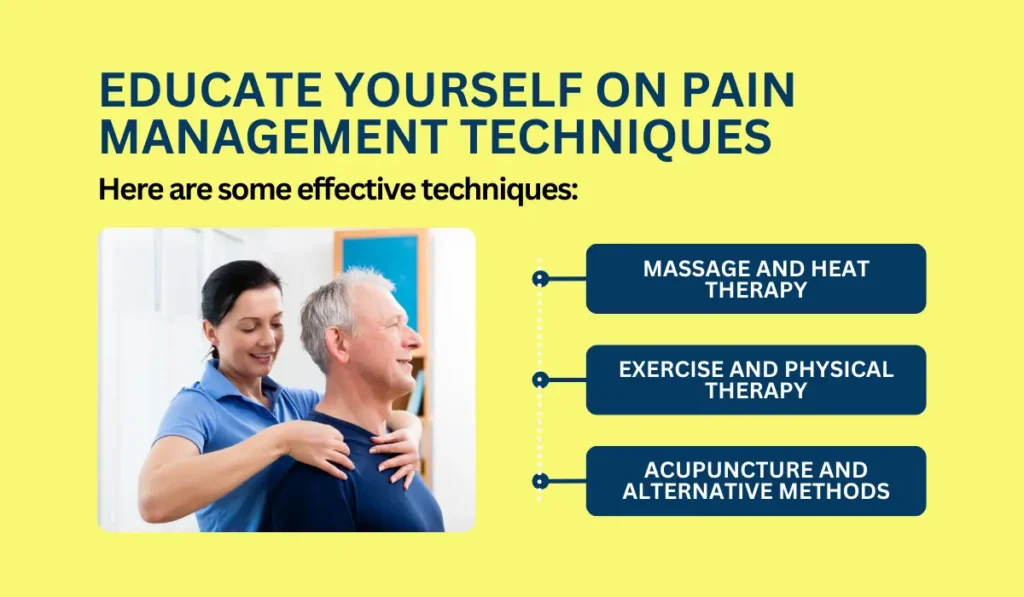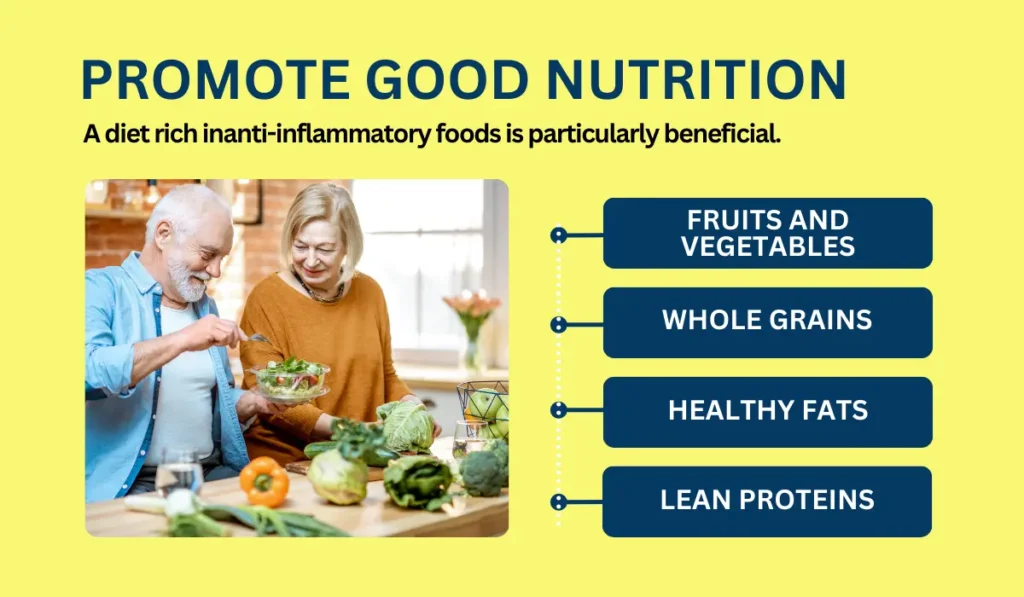Caring for an elderly loved one with chronic pain can be tough for both caregivers and family members. Chronic pain can impact daily activities of life and well-being, and it’s often hard to know where to start. But don’t worry—this guide is here to help.
We’ve got ten practical tips to manage chronic pain in older adults, from pain relief techniques and physical therapy to mental health support.
Key Takeaways
- Eat more fruits, vegetables, whole grains, healthy fats, and lean proteins. Avoid processed foods, sugary drinks, and red meat.
- Address the emotional side of chronic pain with physical activities, mindfulness, therapy, and social connections.
- Regularly check levels of pain using self-reports, observations, and physiological indicators.
- Promote social connections through visits, virtual meetings, and community involvement to boost mental and emotional health.
1. Understand the Pain
Chronic pain varies greatly, affecting each person uniquely. Identifying the type of pain your loved one is experiencing is crucial for optimal care. Prevalent types include:
- Neuropathic Pain: Nerve damage, described as shooting or burning.
- Nociceptive Pain: Tissue damage, felt as aching or throbbing.
- Inflammatory Pain: Immune response causing swelling and discomfort.
- Functional Pain: No obvious injury or inflammation. Seen in conditions like fibromyalgia.
- Persistent Pain: Long-term pain that continues beyond the usual recovery period.
- Acute Pain: Short-term pain that occurs suddenly due to a specific injury or illness.
Pain conditions like arthritis, neuropathy, and back pain are common in older adults. That’s why regular pain assessments are essential. By routinely checking pain intensity, you can tailor treatments and adjust care plans, ensuring the best outcomes for your elderly loved one. Professional home care services are great for helping with this.
2. Educate Yourself on Pain Management Techniques

Start by exploring non-drug methods to reduce discomfort. Here are some effective techniques:
- Massage and Heat Therapy: Massage relieves muscle tension and improves circulation, promoting relaxation and pain relief. Heat therapy, using heating pads or warm baths, increases blood flow and relaxes muscles, easing pain.
- Exercise and Physical Therapy: Gentle activities like stretching, walking, and swimming strengthen muscles and improve flexibility. Physical therapy offers targeted exercises to address specific pain points and boost mobility.
- Acupuncture and Alternative Methods: Acupuncture can help manage chronic pain and improve overall well-being.
3. Create a Comfortable Environment
Adjusting the living space to reduce pain triggers can improve an older adult’s quality of life and home safety. Here are some tips to make their home more comfortable and supportive:
- Furniture and Bedding: Use ergonomic chairs and desks to maintain good posture and support musculoskeletal health. Choose a mattress and pillows that support the spine.
- Lighting and Foot Support: Ensure the home is well-lit to avoid eye strain and headaches. Use anti-fatigue mats in standing areas and supportive footwear to ease joint pain and improve comfort.
- Storage and Assistive Devices: Keep frequently used items within close reach to avoid bending or stretching. Use grab bars, reacher tools, and cushions for safety and comfort.
A well-organized home may also encourage social interactions, perhaps by creating comfortable seating areas for guests, reducing the risk of isolation. These adjustments can make a living space that minimizes pain and promotes well-being for your elderly loved one.
4. Encourage Gentle Exercise
Exercise is essential for managing pain and improving the quality of life for older people. Regular physical activity strengthens muscles, enhances flexibility, and boosts endurance, helping to alleviate chronic pain and reduce the need for medications.
Choose safe and suitable exercises for their needs, such as:
- Stretching: Gentle stretches improve flexibility, reduce stiffness, and enhance mobility.
- Water Aerobics: Water exercises provide resistance without straining joints, which is ideal for those with arthritis or joint pain.
5. Monitor Medication
Tracking medication for severe pain and managing chronic conditions is crucial. Medications like non-steroidal anti-inflammatory drugs (NSAIDs), acetaminophen, antidepressants, and other analgesics are often necessary for pain relief.
However, being aware of potential side effects, such as constipation, cognitive impairment, and cardiovascular issues, is essential.
This is especially important when dealing with comorbidities (i.e., multiple health issues), as managing chronic pain often requires additional medications.
To deal with this effectively:
- Set reminders on a phone or use a medication-tracking app.
- Use a pill organizer to sort medications by the days of the week.
- Monitor side effects and journal any issues, noting the time and severity.
- Regularly communicate with the healthcare provider about any concerns or side effects to make necessary adjustments.
6. Lean on Technology
Various tools and gadgets can greatly improve chronic pain management. Wearable devices, like smartwatches and fitness trackers, offer real-time monitoring and relief, providing feedback on physical activity and posture, and delivering therapeutic interventions like heat or vibration.
Useful technologies for managing chronic pain include:
- Smartwatches: For real-time health monitoring.
- Wheelchairs: For easier mobility. See which wheelchair is best for your senior.
- Pain Management Apps: These are used to track pain and identify triggers.
- Mobile Health Apps: For medication reminders and progress logging.
- Personal Alarm Devices: For emergencies, such as falling down.
7. Promote Good Nutrition

What you eat can have a big impact on chronic pain, affecting its intensity and frequency. Eating the right foods can reduce inflammation, ease symptoms, and boost overall well-being.
A diet rich in anti-inflammatory foods is particularly beneficial. This includes:
- Fruits and Vegetables: Packed with antioxidants and nutrients, they combat inflammation and support immune function.
- Whole Grains: Foods like quinoa, brown rice, and oats provide fiber and essential nutrients that reduce inflammation.
- Healthy Fats: Omega-3 fatty acids in fish, flaxseeds, and walnuts help reduce inflammation and pain.
- Lean Proteins: Sources like chicken, turkey, and plant-based proteins support muscle repair and overall health.
Conversely, certain foods can make chronic pain worse and should be avoided. Processed foods high in trans fats, sugars, and additives increase inflammation. Sugary beverages and snacks can also worsen pain.
Red meat and high-fat dairy promote inflammation and should be eaten in moderation.
8. Assist with Mental Health Support
Chronic pain and mental health are tightly linked. In fact, 54% of individuals with chronic pain experience severe anxiety. Unfortunately, constant pain can harm emotional well-being, leading to increased stress, anxiety, and depression.
Addressing both the physical and emotional aspects of chronic pain is essential for effective management.
To support emotional well-being, consider these strategies:
- Engage in Physical Activities: Gentle exercises like walking, swimming, or yoga can release endorphins and improve mood.
- Practice Mindfulness and Meditation: These practices can reduce stress and enhance mental clarity, helping to manage pain.
- Seek Professional Therapy: Cognitive-behavioral therapy (CBT) and other counseling can provide coping mechanisms and support.
- Stay Connected with Others: Social interactions can reduce isolation and offer emotional comfort.
9. Regularly Evaluate Pain Levels
Regularly assessing pain levels is essential for providing the best care for elderly individuals. Effective pain assessment involves several techniques:
- Patient Self-Reporting: This is considered the gold standard. Patients communicate their pain levels using scales or questionnaires.
- Observational Methods: Healthcare professionals note changes in behavior, facial expressions, and physical reactions that indicate pain.
- Physiological Indicators: Monitoring vital signs such as heart rate and blood pressure can also provide insight into a patient’s pain experience.
10. Encourage Social Connections
Encouraging social interactions is crucial for combating isolation in elderly individuals. Strong social bonds can significantly improve mental and emotional well-being, reducing loneliness.
Effective strategies include:
- Organizing Regular Visits: Schedule consistent visits with family and friends.
- Setting Up Virtual Meetings: Use video calls when in-person gatherings aren’t feasible.
- Participating in Community Events: Join social clubs or community events to build a wider network.
Fostering these interactions can help elderly individuals experience a greater sense of belonging and support, which is essential for overall health and happiness.
| Please note that the content provided on this blog is for informational purposes only and is not intended as medical advice. Always consult a healthcare professional before making any decisions about your health. |